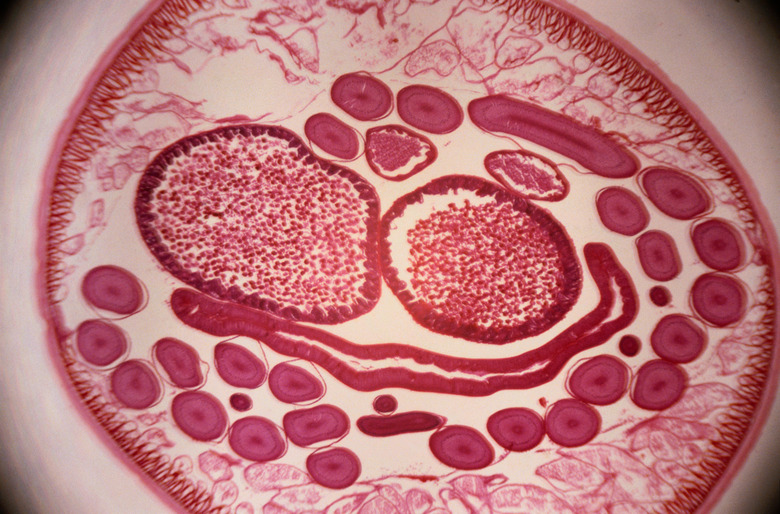Physical Adaptations Of Roundworms
With over 15,000 known species, the adaptive features of roundworms have allowed the worms to survive and flourish in a variety of environments and habitats. Roundworms (also known as nematodes) exist as parasites or as free living organisms and play a role as decomposers that break down organic materials to be utilized by bacteria. Roundworms do not have circulatory or respiratory systems and therefore have adaptations that help with the distribution of food, liquids, and gases.
Roundworm Classification
Roundworm Classification
Roundworms are a type of animal within the phylum nematoda. While they are closely related to flatworms, they are distinctly different from them as a result of their tubular digestive system and other characteristics.
It's hard to differentiate the various roundworm species, especially since there are over 15,000 species currently known and are found in almost every biome/ecosystem on Earth. You'll often find them classified based on where their roundworm habitat and, if they're parasitic, what their host organism is.
Characteristics of Roundworms: A Simple Structure
Characteristics of Roundworms: A Simple Structure
Roundworms are characterized by a simple worm-like structure with a lack of features such as cilia or a well-defined head. They have an internal body cavity, called a pseudocoelom, which looks like a tube within a tube and runs the whole length of their bodies. This inner tube is the alimentary canal of the roundworm and extends from the mouth to the anus. The pseudocoelom contains the intestines and reproductive organs of the roundworms.
Read more about what a roundworm looks like.
External Cuticle
External Cuticle
The body of a roundworm has an epidermis, or skin, composed of a mass of cellular material and nuclei without separate membranes. This skin secretes an outer cuticle which is thick, tough and flexible. This cuticle is molted usually four times before the roundworm reaches the adult stage. The cuticle provides structural support and, along with longitudinal muscles, allows the roundworms to bend from side to side and to move in a thrashing manner.
The cuticle is permeable by fluids and gases, thus allowing respiration to occur over the whole body. The adaptation of a hard and flexible yet permeable skin cuticle enables roundworms to maintain their internal fluids under high pressure.
Nervous System
Nervous System
Roundworms have a nervous system with circum-pharyngeal nerve rings, longitudinal nerves that run through the body to the digestive and reproductive organs. Shorter nerves extend to the mouth from the nerve rings. The muscle cells of nematodes branch towards the nerves and there are a series of nerve centers along the length of the roundworms.
Two nerve cords serve to activate the muscles. The nerve cords relay sensory information with tactile, chemosensory and light sensitive receptors and help with movement.
Digestion
Digestion
The head of roundworms contains a few small sense organs and a pharynx where food is pulled in, crushed, and then moves to the gut cavity. Nutrients and wastes are spread throughout the body cavity by diffusion and regulated by an excretory canal or tubules on each side of the body. Nitrogen waste is expelled through special cells called rennette cells directly through the body wall. The digestive system of the roundworms includes a mouth with teeth, a gut, anus and a pharynx.
Reproduction
Reproduction
Most roundworms have separate sexes where the males utilize a specialized spine to inject sperm into the female's reproductive tract through a mid-body hole called a gonophore. Most roundworms lay eggs which can be highly resistant to adverse environments such as dry, hot or cold conditions. Roundworms lay up to 27 million eggs at a time.
Read more about how roundworms reproduce.
Eutely
Eutely
Every individual of the roundworm species has the exact same number of cells. This is called "eutely." Growth in roundworms is by an increase in the size of the cells instead of by an increase in the number of cells.
Cite This Article
MLA
Durr, Julie. "Physical Adaptations Of Roundworms" sciencing.com, https://www.sciencing.com/physical-adaptations-roundworms-7322655/. 29 July 2019.
APA
Durr, Julie. (2019, July 29). Physical Adaptations Of Roundworms. sciencing.com. Retrieved from https://www.sciencing.com/physical-adaptations-roundworms-7322655/
Chicago
Durr, Julie. Physical Adaptations Of Roundworms last modified March 24, 2022. https://www.sciencing.com/physical-adaptations-roundworms-7322655/
